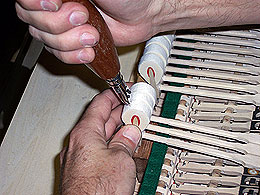 Voicing a piano changes it’s tone. Some like a bright, clear tone while others may prefer a warmer, rounded sound. Quality pianos can often deliver a broad, dynamic range of tonal characteristics. A well voiced piano inspires piano playing and encourages musical growth.
Voicing a piano changes it’s tone. Some like a bright, clear tone while others may prefer a warmer, rounded sound. Quality pianos can often deliver a broad, dynamic range of tonal characteristics. A well voiced piano inspires piano playing and encourages musical growth.
Just like the human voice, pianos are very unique when it comes to tone. And, just like people, some can sing beautifully and others just cannot. I find that one of the biggest reasons a person prefers one piano over another is due to its overall tone, what we call its voice.
“Thank you very much for voicing the [Steinway] piano. There is a huge difference in the way it sounds. I really appreciate all the time & effort you put in to make it sound better.”
~~ D’Laney J. – Classical Pianist
Why do some Pianos have good tone and others Do Not?
The design of modern pianos has changed little for more than a century. The materials used for piano making are the same today as they were from its early beginnings – wood, cloth, leather, and metal. So if all pianos are made in a similar fashion from the same materials, why do some sound better than others? The answer lies in the details.
Let’s start with the raw materials. Not all wood is created equal. Some species, like spruce and maple have better characteristics needed for piano manufacturing. But even within the same species, some pieces of wood have better acoustic and strength qualities used to build finer instruments with better tone. Wool and cloth, used to make hammers, dampers, and bushings varies by the manufacturing process and animal origin. Leather and other synthetic equivalents vary from the same things as well. And even metal, used primarily for the cast-iron metal plate, can impart differing tonal qualities on a piano.
Then, of course, some pianos are just of better design. One of the biggest factors of piano design is size. Bigger pianos will generally sound better, especially in the bass end. Consequently, smaller pianos are much more challenging to design and still sound good. I won’t go into the reasons why, but just know that, because of natural laws of physics, when it comes to piano tone – BIGGER IS BETTER.
How is a Piano Voiced?
The process of piano voicing primarily involves changing (improving) the interaction of the felt hammers and the pianos strings. When a piano key is played, a series of levers are set in motion, which eventually drive a wool hammer, causing it to quickly strike an open string. The firmness, shape, and flight characteristics of that hammer all influence the way it strikes the string. Voicing a piano changes those three characteristics.
The shape of a hammer changes with usage as it becomes flattened on top and develops grooves from hitting the strings over and over. Part of a thorough voicing job involves re-shaping the hammer by filing it. This must be done evenly and precisely so that it contacts the strings squarely each time it is played.
The firmness of a hammer is altered by inserting needles into specific areas of the hammer (see picture above). Needling a hammer allows technicians to build piano tone and volume, and control the brightness or warmth desired. The end goal is to create a hammer with excellent resiliency. One that will strike the strings and quickly bounce off.
Another method of changing the firmness of a hammer is through the use of chemical hardeners and softeners. Lacquer and lacquer thinner are commonly used. Manufacturers of higher end pianos, such as Steinway, will make hammers specifically designed to have lacquer added as a way to build power and volume into their instruments. This traditional method requires a very careful placement and quantity of lacquer to ensure the correct results.
The flight characteristic of the piano hammer can have a huge influence on the tone of a piano. Hammers and their corresponding action parts must be well regulated (adjusted) to produce optimal tone. Some pianos leave the factory poorly voiced and regulated, and sadly, never receive any additional improvement throughout its life. While others, like those used for concert environments, may be continually refined and maintained at the highest level possible.
If you would like to learn even more about piano voicing, check out this excellent VOICING Technical Bulletin published by the Piano Technicians Guild.